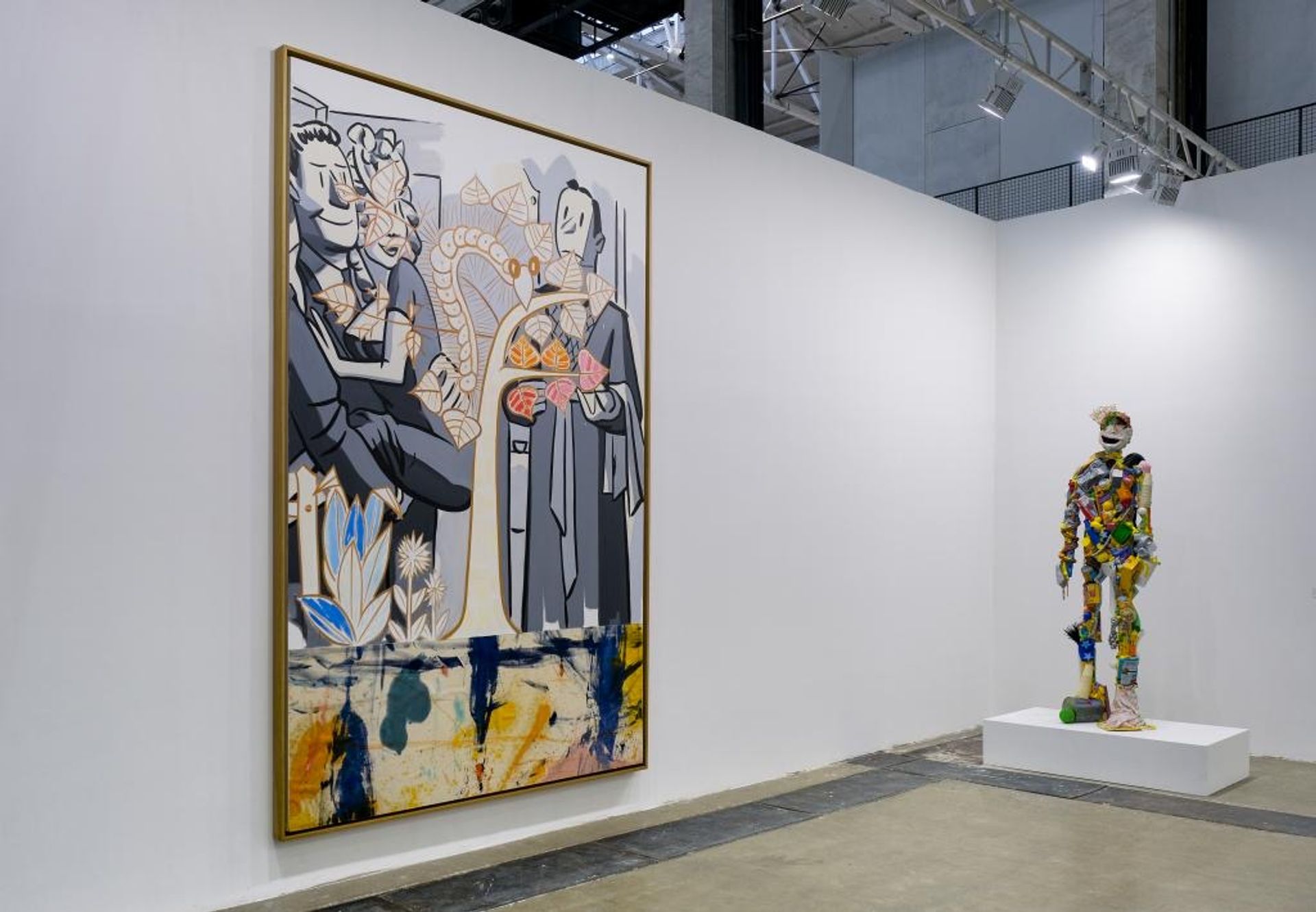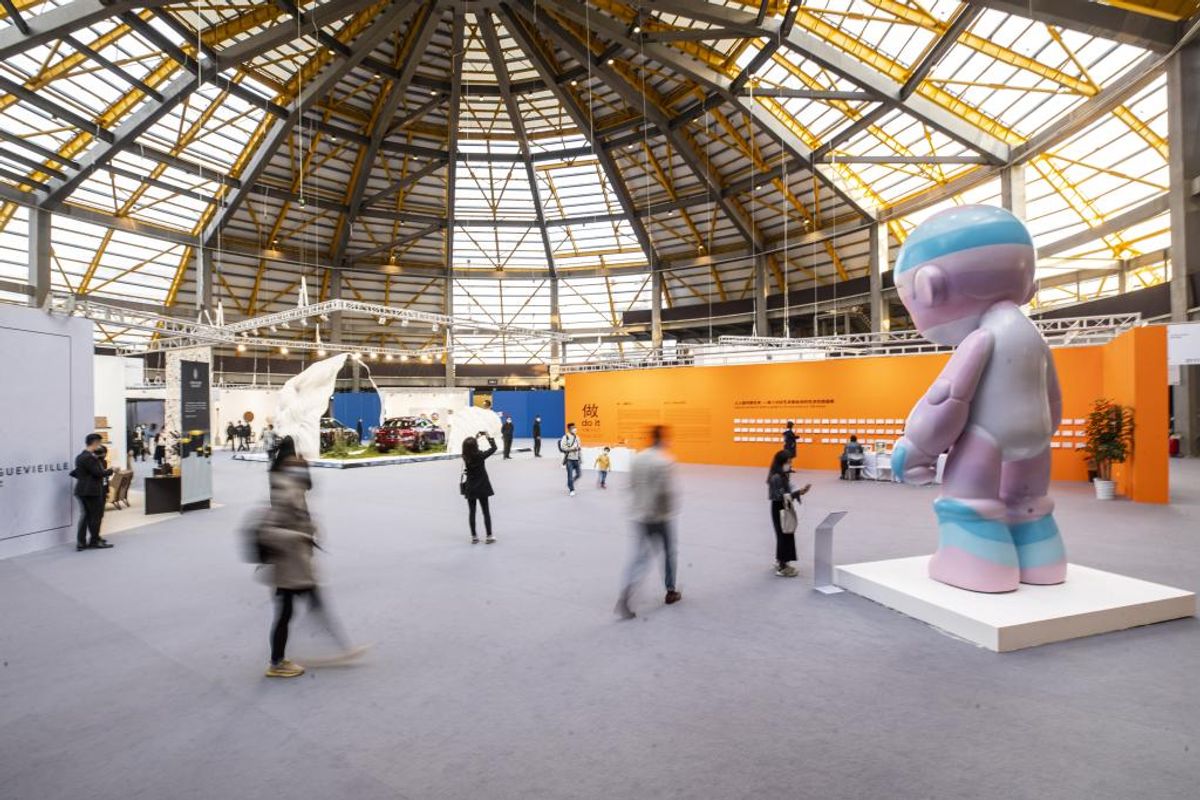Shanghai’s two flagship fairs Art021 and the West Bund Art & Design Fair (both 11 to 14 November) concluded on Sunday, to mixed results and spirits after patchy sales performances.
After the jubilant post-lockdown return that was the 2020 Shanghai art week, this year’s season felt scattered and comparatively subdued. The mood was cheerful but fatigued from ongoing and newly tightened Covid restrictions and nervous about intensified censorship and a Beijing plenum further consolidating the power of Chinese president Xi Jinping. Still, the purchasing power of an expanding domestic collector base unable to travel overseas fueled overall satisfactory sales.
“The vibe was jovial, with newer and younger collectors showing really serious interest and buying. Though it can be hard to gauge age with masks on, they were buying blue-chip art,” says Dawn Zhu, Thaddaeus Ropac’s director of Asia. New collectors included new institutions opening in second tier cities like Qingdao, Chengdu and Shenzhen. Zhu says works in the US$150,000 to $200,000 range sold well. “Clients may not know the artists so well, but after seeing them at other galleries previously…and having some awareness of them, they can make a decision within the first few hours.” However, works above a million dollars were either presold or required further discussion. Ropac sold Jason Martin’s Untitled (Ultramarine Blue, 2020) for £65,000, Yan Pei-Ming’s Autoportrait, le déni (2020) for €80,000, and several pieces between $45,000 to $55,000 by Mandy El-Sayegh, “who we could have sold many times over.” Collectors were interested in their blue-chip core but also very curious about rising stars, and particularly “want artists with links to China or influencing Chinese artists like Rauschenberg.”

Lehmann Maupin's stand at West Bund
Courtesy of Lehmann Maupin
Tiffany Xu, Lehmann Maupin’s China director, also observed a proliferation of young collectors. “My most intuitive feeling is that new collectors have a cutting-edge vision and have diversified channels for obtaining information. They also show a stronger interest in young [and more diverse] artists.” She adds that sales “went very well this year” albeit slower than last year, although “there are still a number of deals in discussion.” Xu says other galleries are also conducting similar ongoing post-fair negotiations. Along with placing works by El-Sayegh and Angel Otero in current and forthcoming Beijing museums, Lehmann Maupin sold to Chinese private collections a painting from McArthur Binion’s “Altar” series for $170,000, Otero’s Silence (2020) for $50,000, three works from Lee Bul’s Perdu series for nearly $400,000, along with works by Do Ho Suh and Chantal Joffe, Marilyn Minter and Billy Childish.
Shanghai’s art calendar expanded this year with the new Design Miami/Podium + Shanghai (5 to 14 November) and Photofairs Shanghai (3 to 6 November) rescheduled from its usual September date, plus the openings of new Shanghai spaces for the Longlati, M and CC foundations. Major museums like Long, Yuz and the Power Station of Art held their major openings in late-October, though Ming Contemporary Art Museum (MCAM) unveiled an impressive five-year anniversary respective of Shanghai performance art, and Prada Rongzhai opened a show of Nathalie Djurberg and Hans Berg. Dealers and collectors were this year bifurcated between the two large fairs with identical dates: in prior years they have overlapped but had one or two distinct days. Both resumed full pre-pandemic capacity, with 134 galleries at 021 and West Bund expanding to a third hall, West Bund Dome, mostly containing non-profits, design booths and brand promotions.
According to a fair spokesperson, West Bund Art & Design attracted more than 120 galleries, designer brands and art institutions from 18 countries this year. The addition of the third hall makes this eighth edition of West Bund the largest ever, covering over 30,000 sq m. The spokesperson says overseas galleries accounted for 60%, and “the overlap rate with the first-tier galleries in [Art] Basel reached 50%”. New Covid outbreaks elsewhere in the country meant that the city’s government required Photofairs, West Bund and 021 to mandate all visitors have negative Covid tests within 48 hours, on top of wearing masks and presenting green QR codes, a move that reduced public visitors but not, say dealers, many collectors.

Beyond the Veil (2021) by Vaughn Spann
© Vaughn Spann. Photo: Thomas Mueller. Courtesy of the artist and Almine Rech
As China’s collectors get younger, so do the artists they are interested in, says the West Bund spokesperson. The solo exhibitions brought by more than a dozen galleries to West Bund also confirm this trend: Lévy Gorvy’s “post-1975s” artist Tu Hongtao, “post-80s” Mexican artist Gabriel Rico (Perrotin), the “post-80s” Japanese artist Miwa Komatsu (Whitestone Gallery), and the “post-80s” American artist Sayre Gomez (Xavier Hufkens), “post-80s” Japanese female artists Ed Shiori (A2Z Gallery), and Almine Rech brought “post-90s” artist Vaughn Spann.
Black figurative art was noticeably well-represented at the fair, a new twist in a market usually most interested in white and Chinese artists. Black artists were also evident around the institutional shows: Spann joined Amoako Boafo and Derrick Adams for the Longlati Foundation’s debut exhibition of Black portraiture while M Art Foundation also launched its new Shanghai space, in the former premises of Gallery Vacancy, with a solo presentation of Ghana-based artist Emmanuel Taku. "Black artists, or more precisely, Black history and racial issues have been very focused social topics in recent years,” Xu says, adding that this has been reflected in the art market.
Young collectors are also more enthusiastic about digital spaces, says Zola Shao, the sales and marketing director of de Sarthe Gallery, exhibiting at 021. Their interests, Shao says, are shifting towards “reflections on escapism in the virtual world touching contemporary hot topics such as post-internet, games, and urban landscapes.” Shao says this fueled good sales “for our three post-internet artists Lin Jingjing, Zhong Wei and Mak2,” with works ranging from RMB50,000 to RMB250,000.
Artistic censorship expanded at the fairs this year, well beyond the usual taboos of politics and sexuality. Works that had passed customs censorship and been successfully imported were restricted at the cultural bureau level, usually with no explanation. Foreign artists seem to be scrutinised much more intensely than Chinese artists, who were permitted to show levels of mild nudity that got foreign works banned. Military themes seem to have joined the list of the verboten, and anything containing text must be thoroughly explained to censors. Dealers say they are willing to follow the rules but are perplexed as to where the line is drawn. Some observed that the Chinese Communist Party’s plenary session happening concurrent to the fairs in Beijing had a dampening effect on sales, as Eastern China’s more globalised businesspeople fear the country’s increasing conservatism will only worsen as Xi consolidates his rule through to at least 2027. As borders remain closed indefinitely under a zero-Covid approach, there are fears that two decades of China’s opening up to global engagement may be reversed.
Still, political shifts are no more likely to dampen China’s artistic juggernaut than the pandemic and closed borders. “The enthusiasm for art collecting, and owning art, is not going away,” Zhu says. “Chinese demand is also driving new artists worldwide. There is a lot of economic firepower here.”


